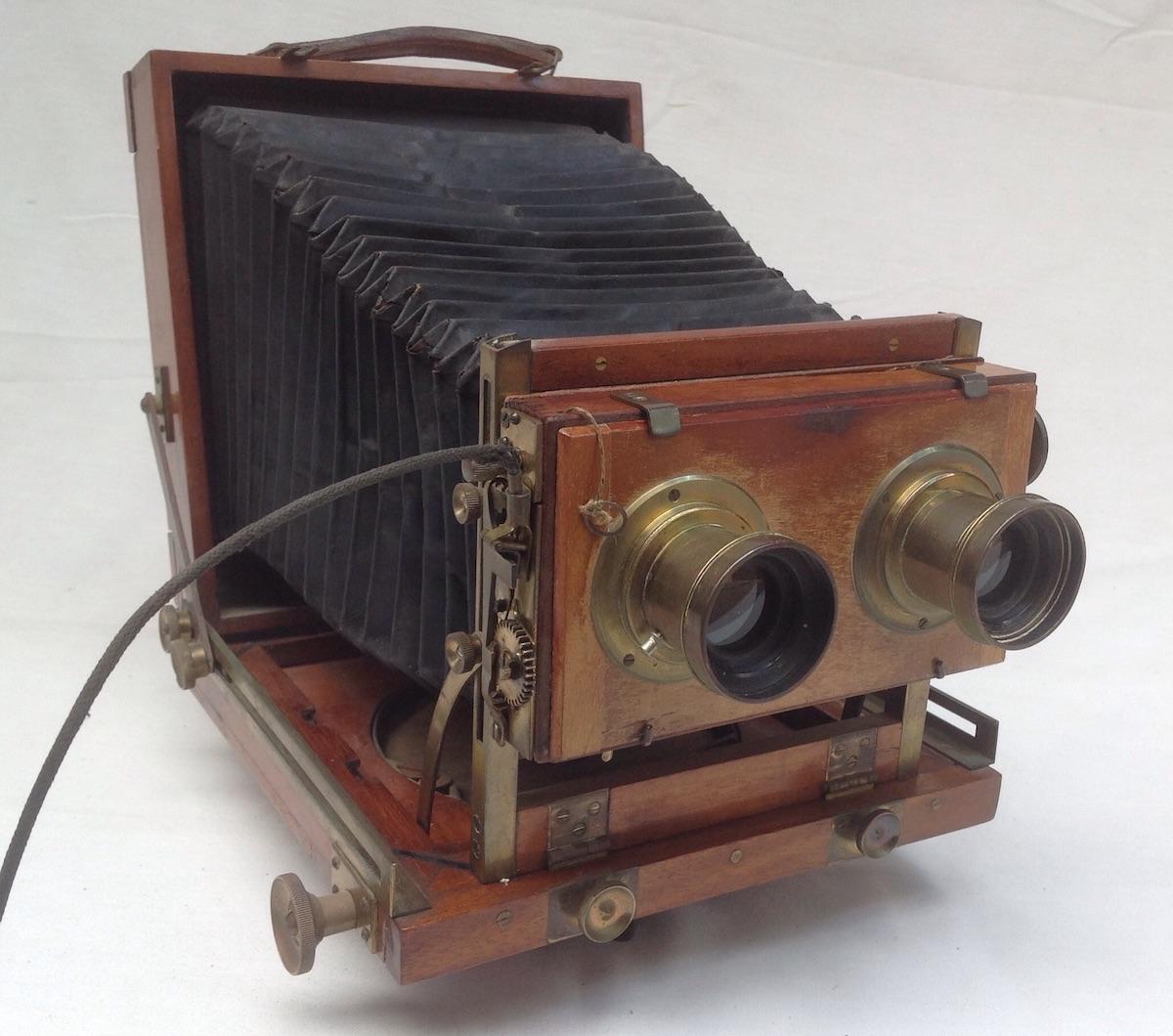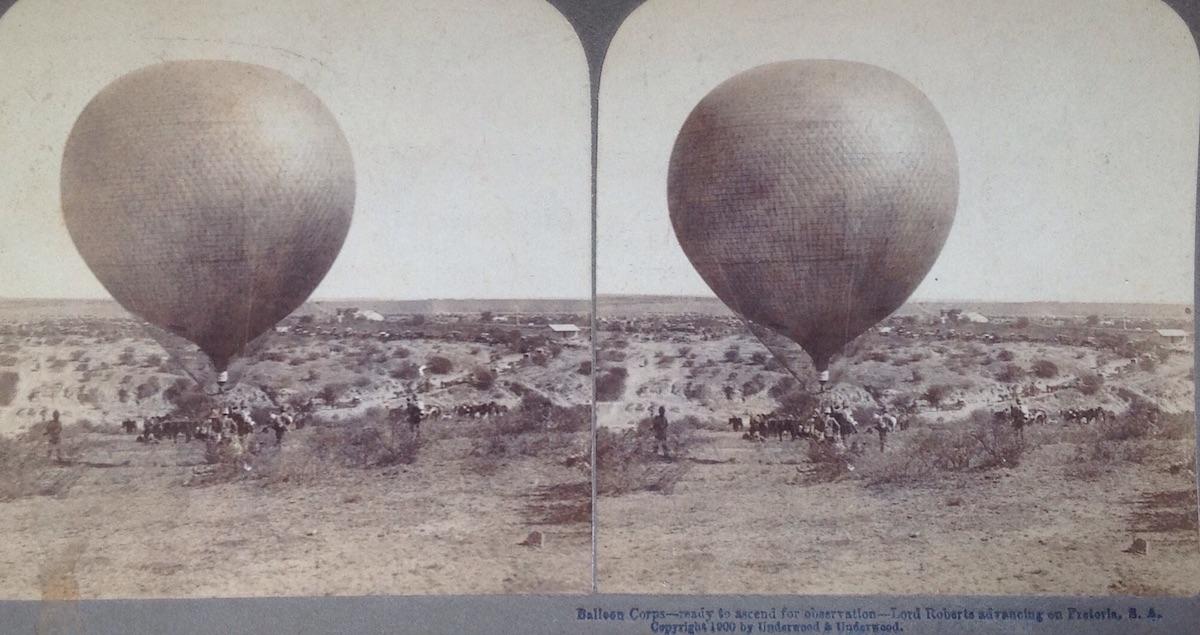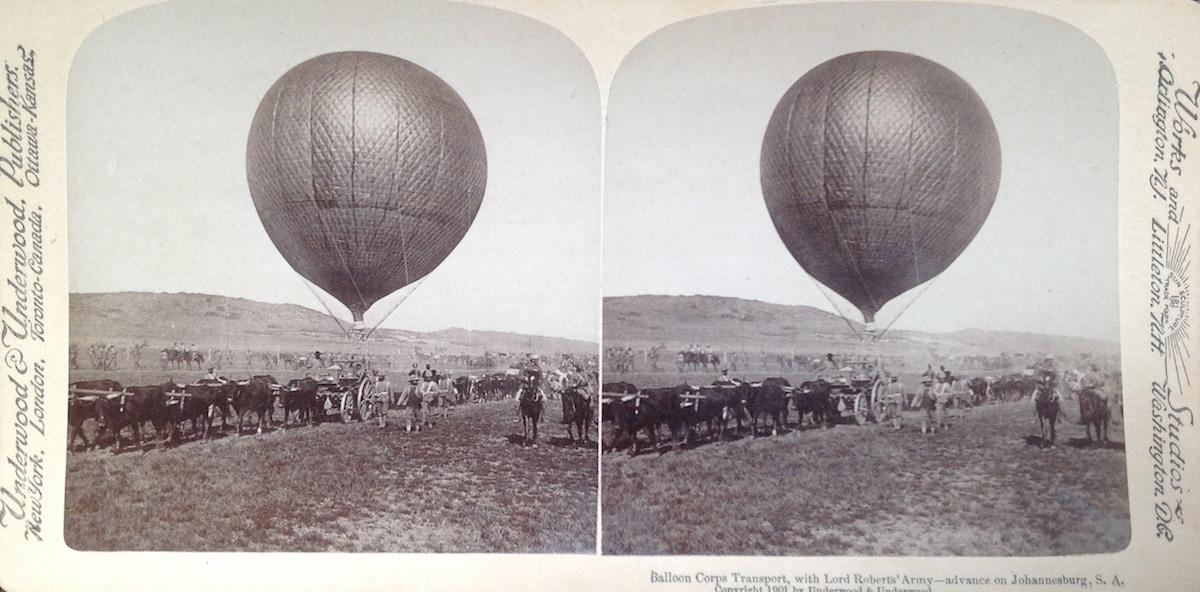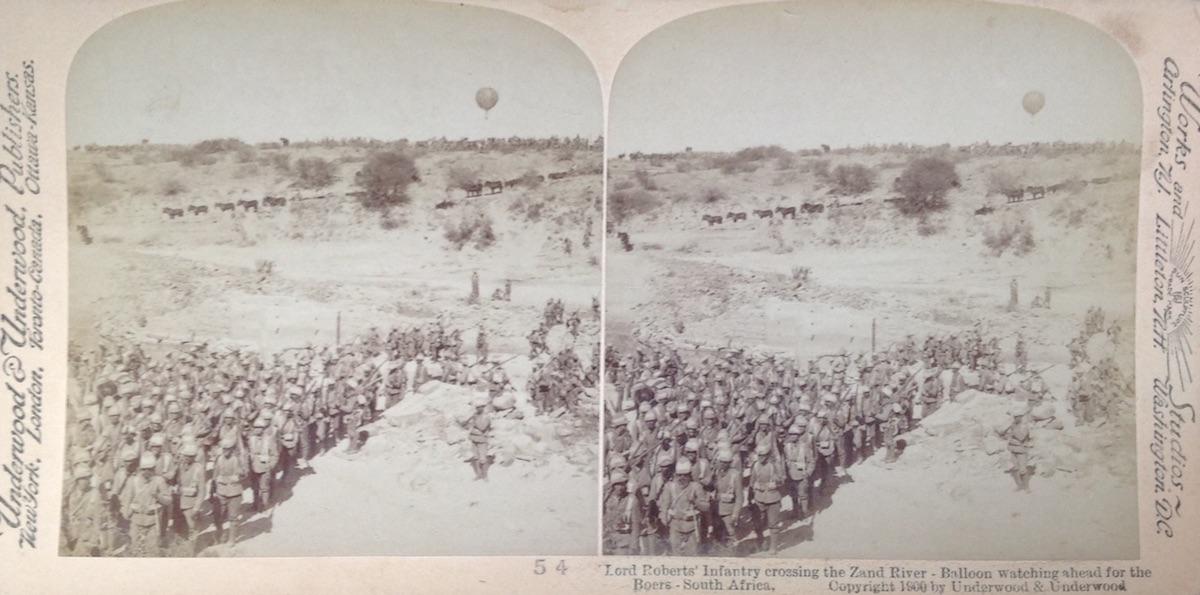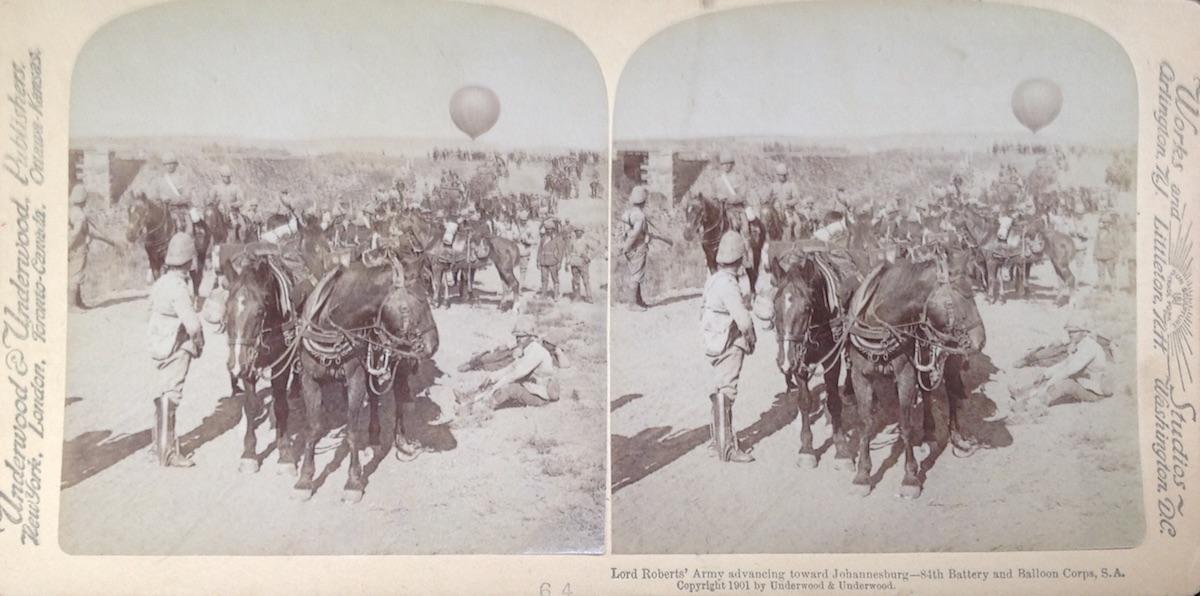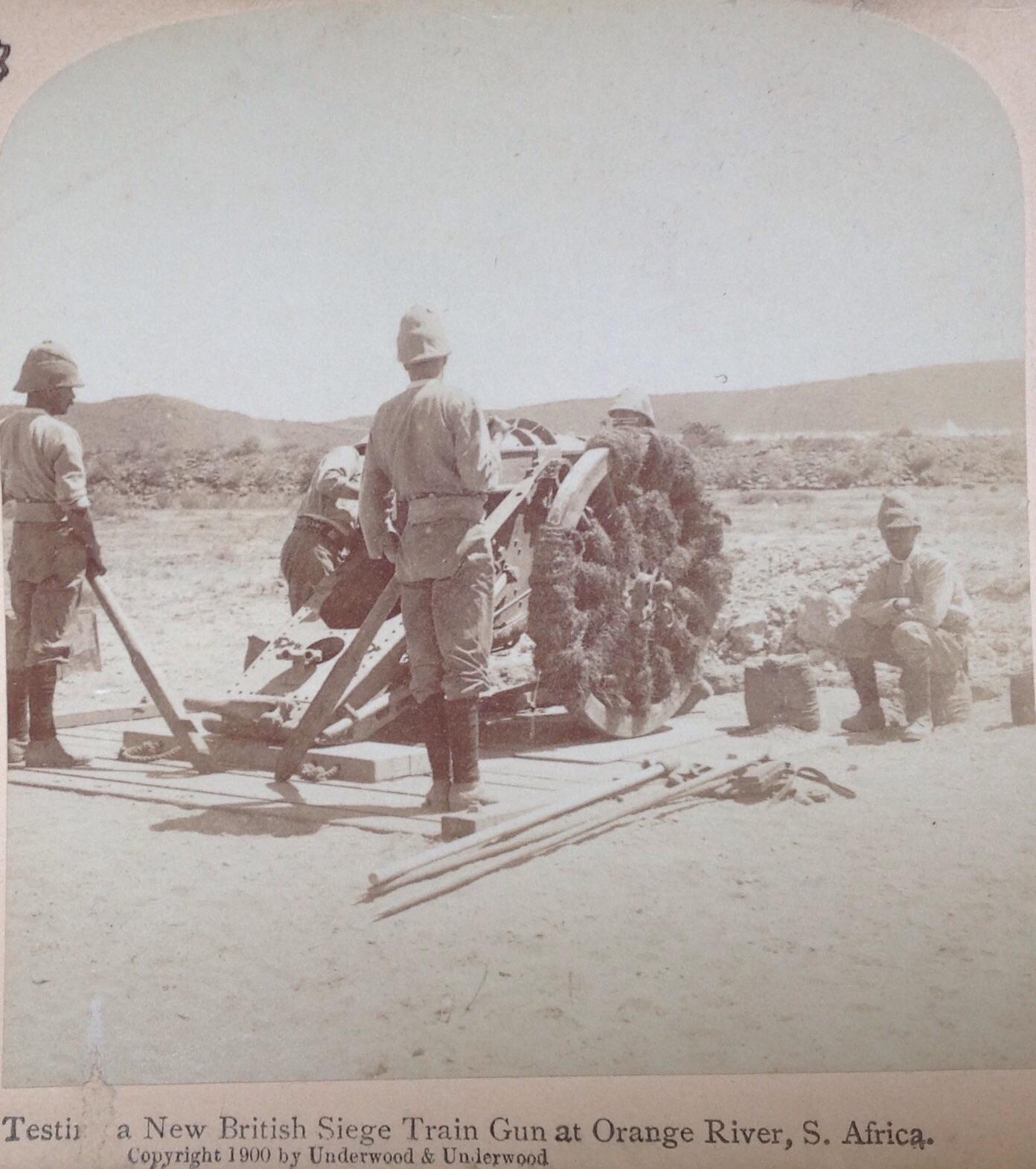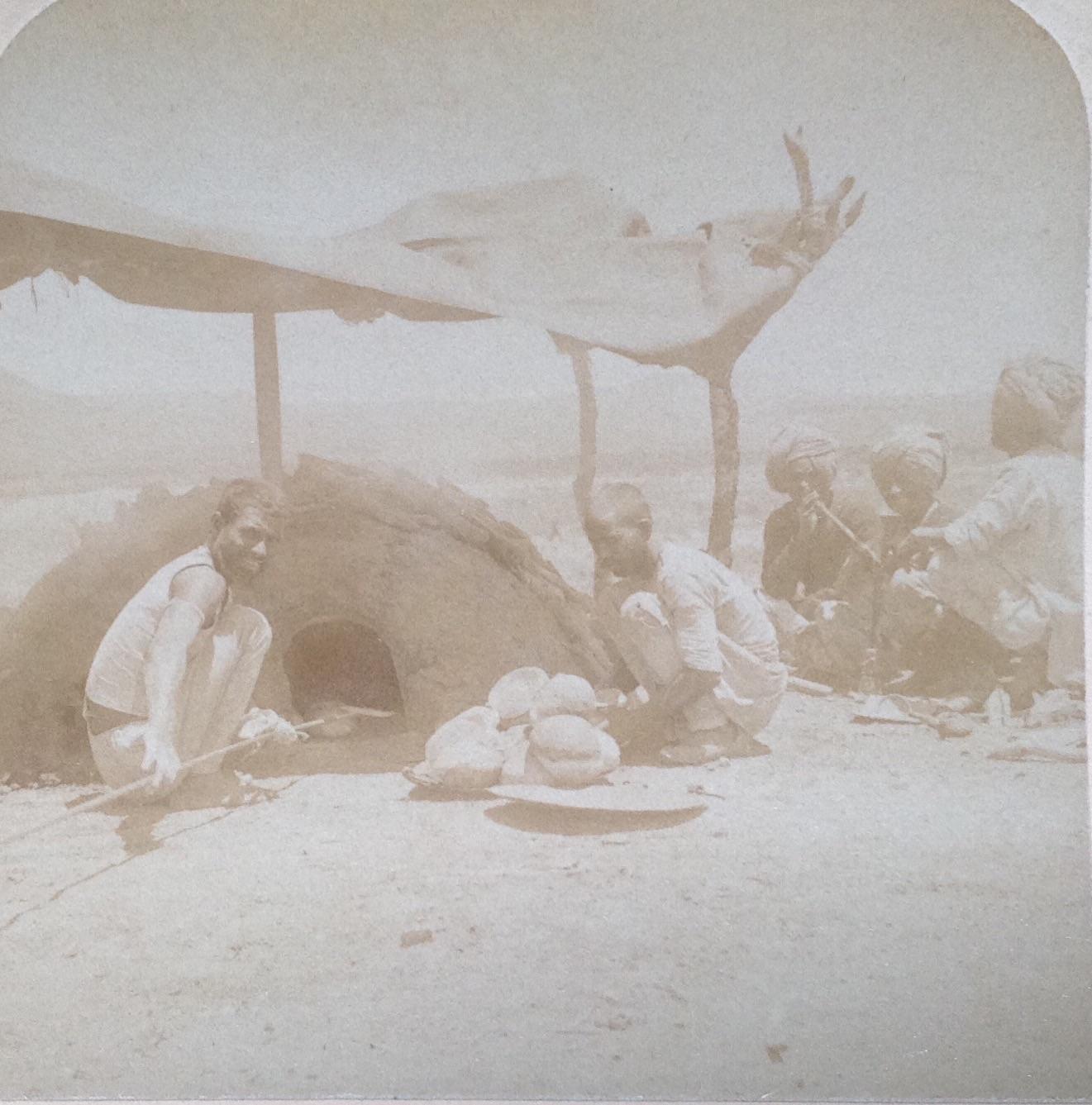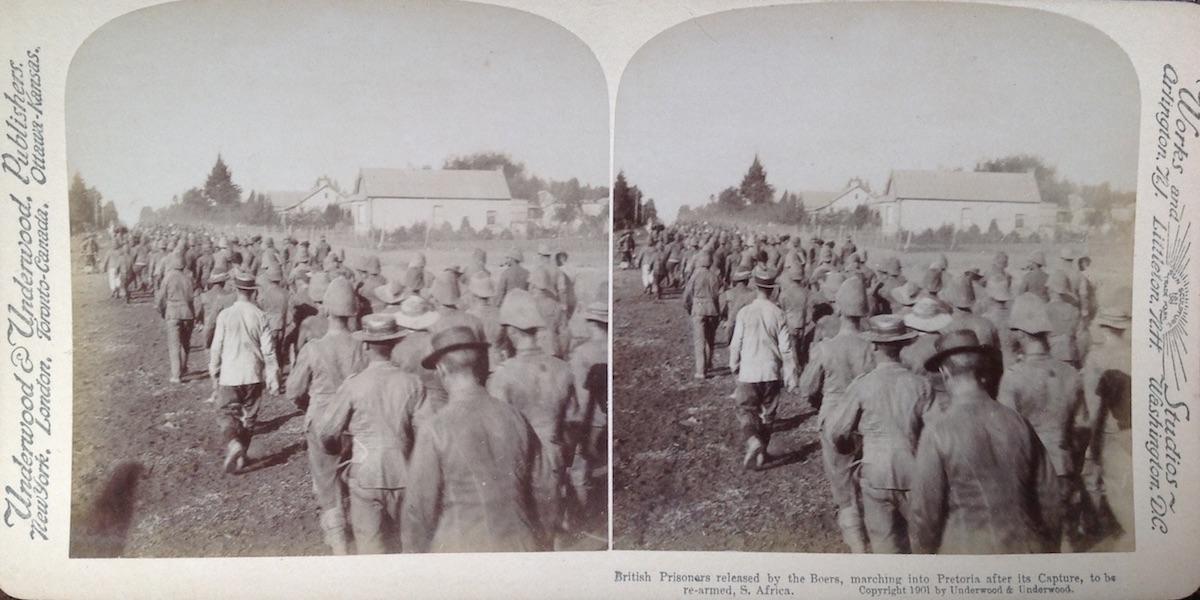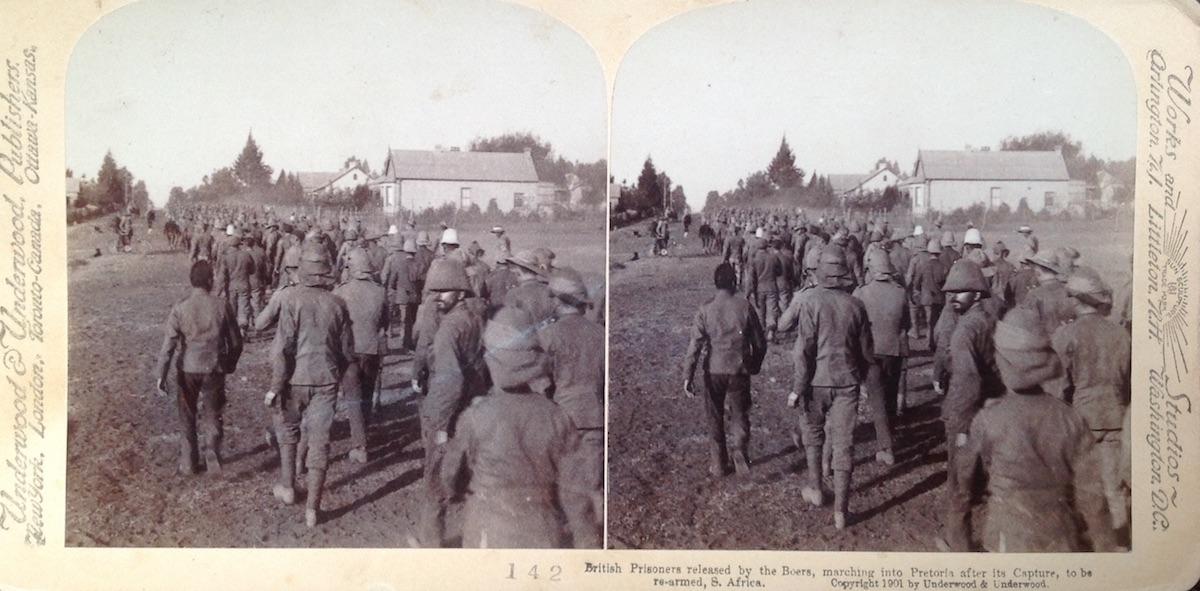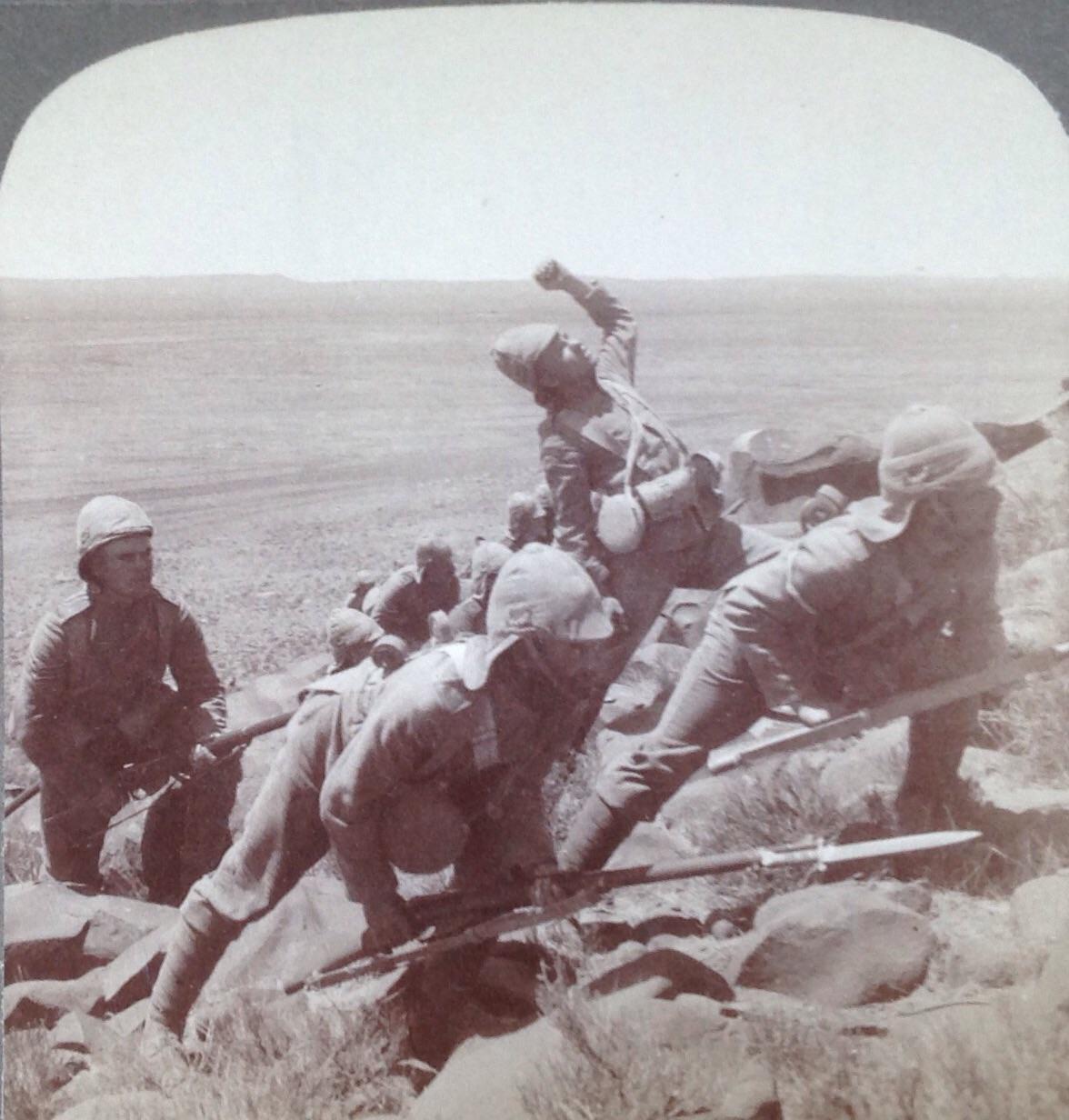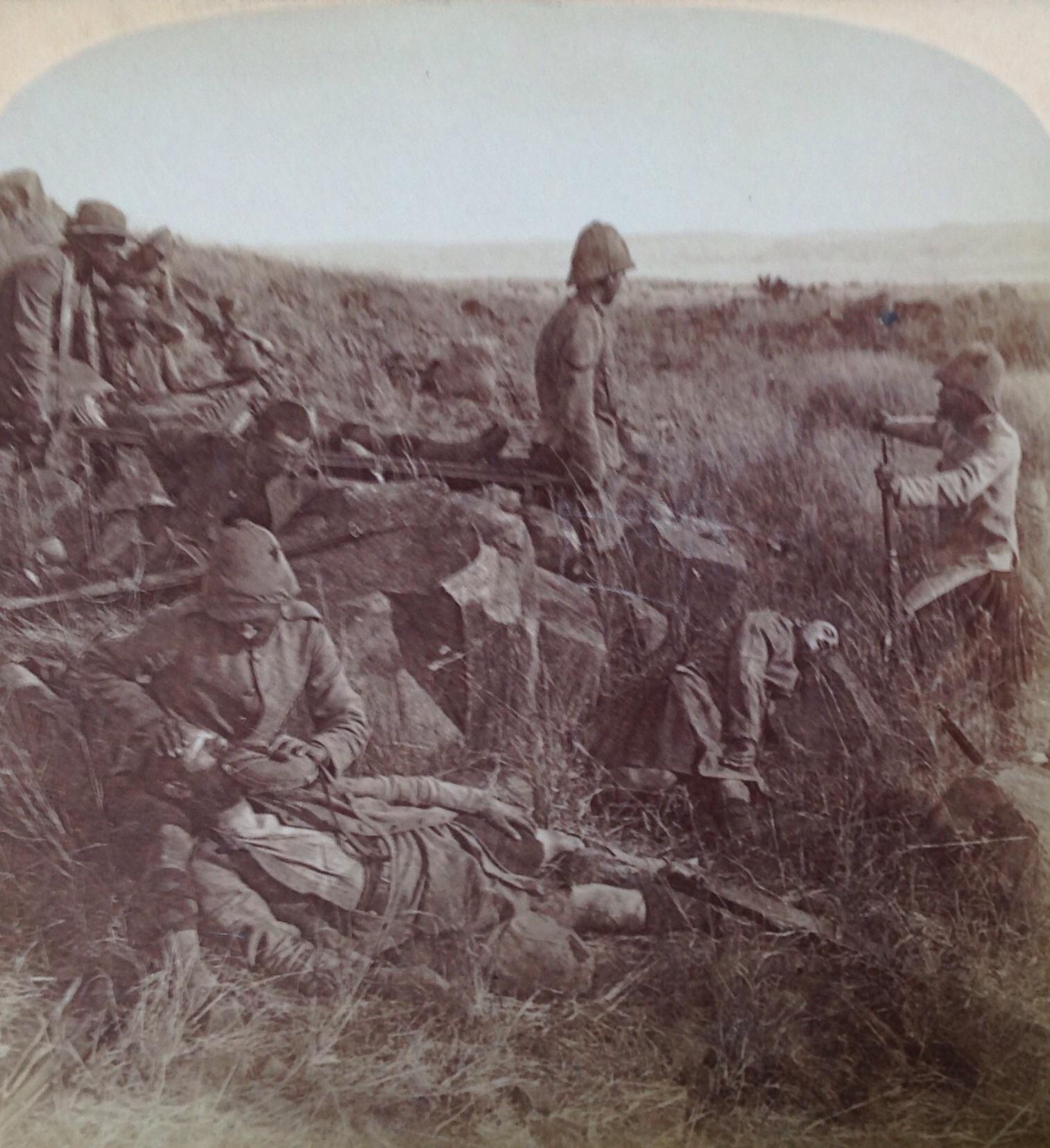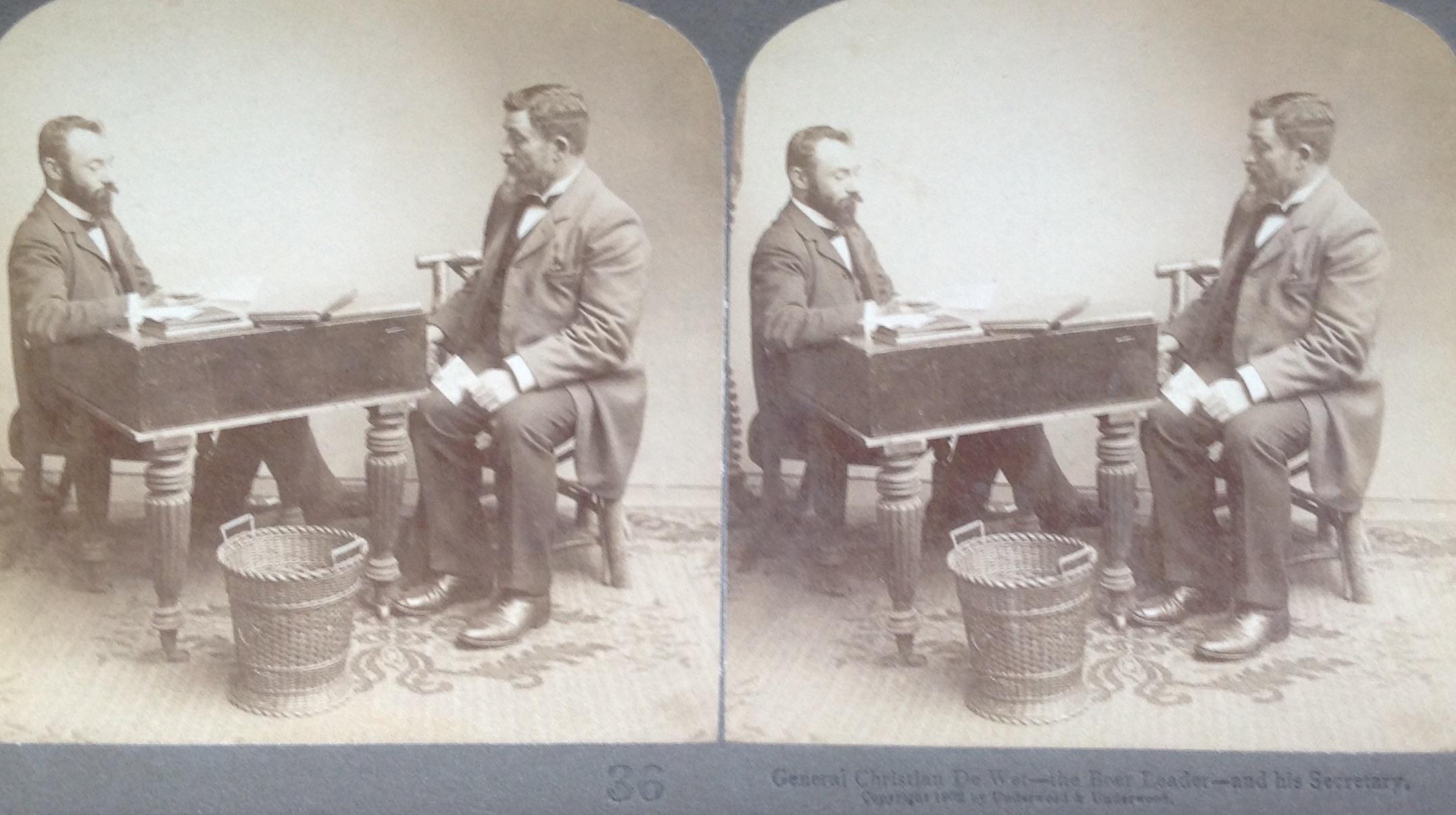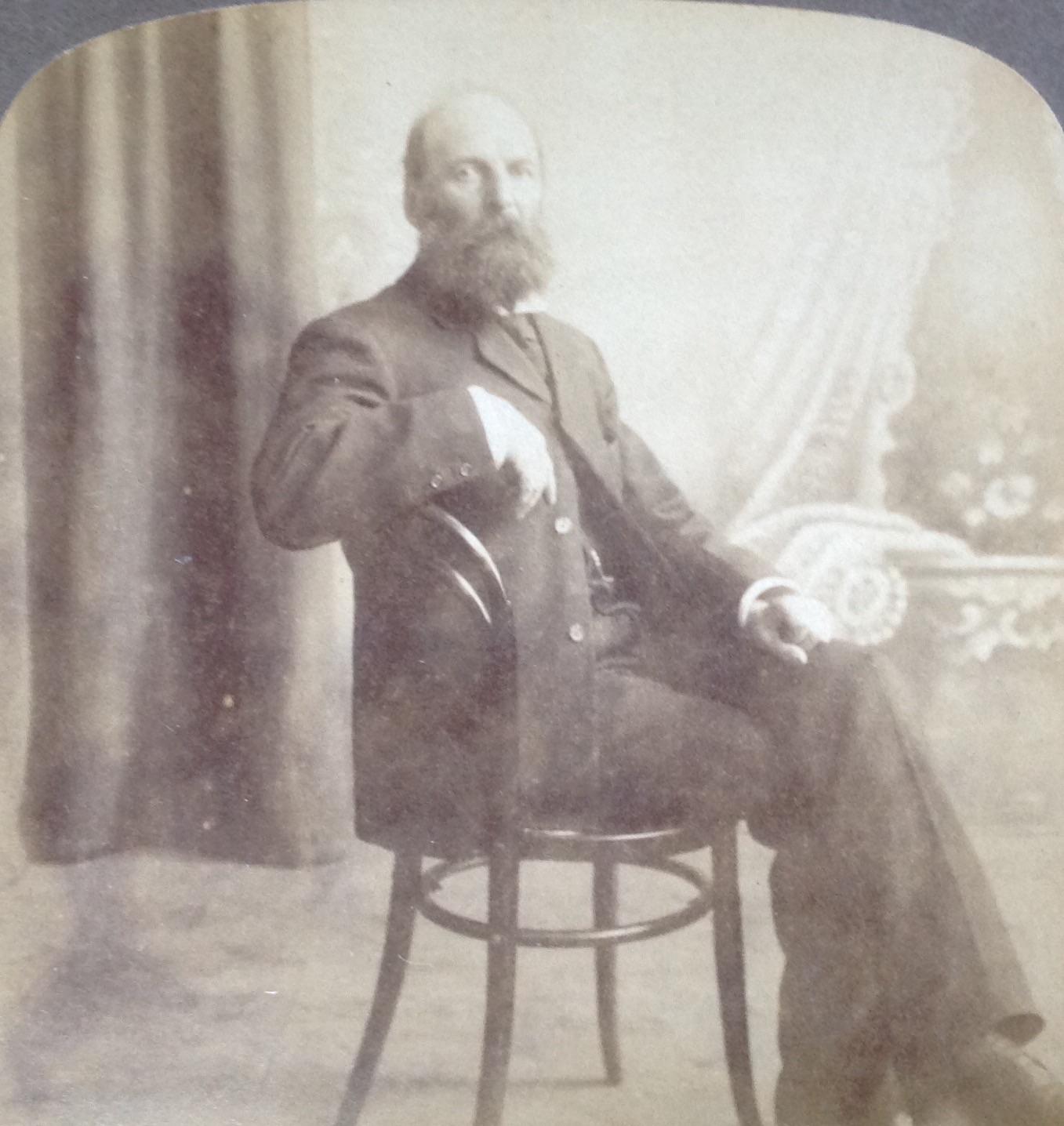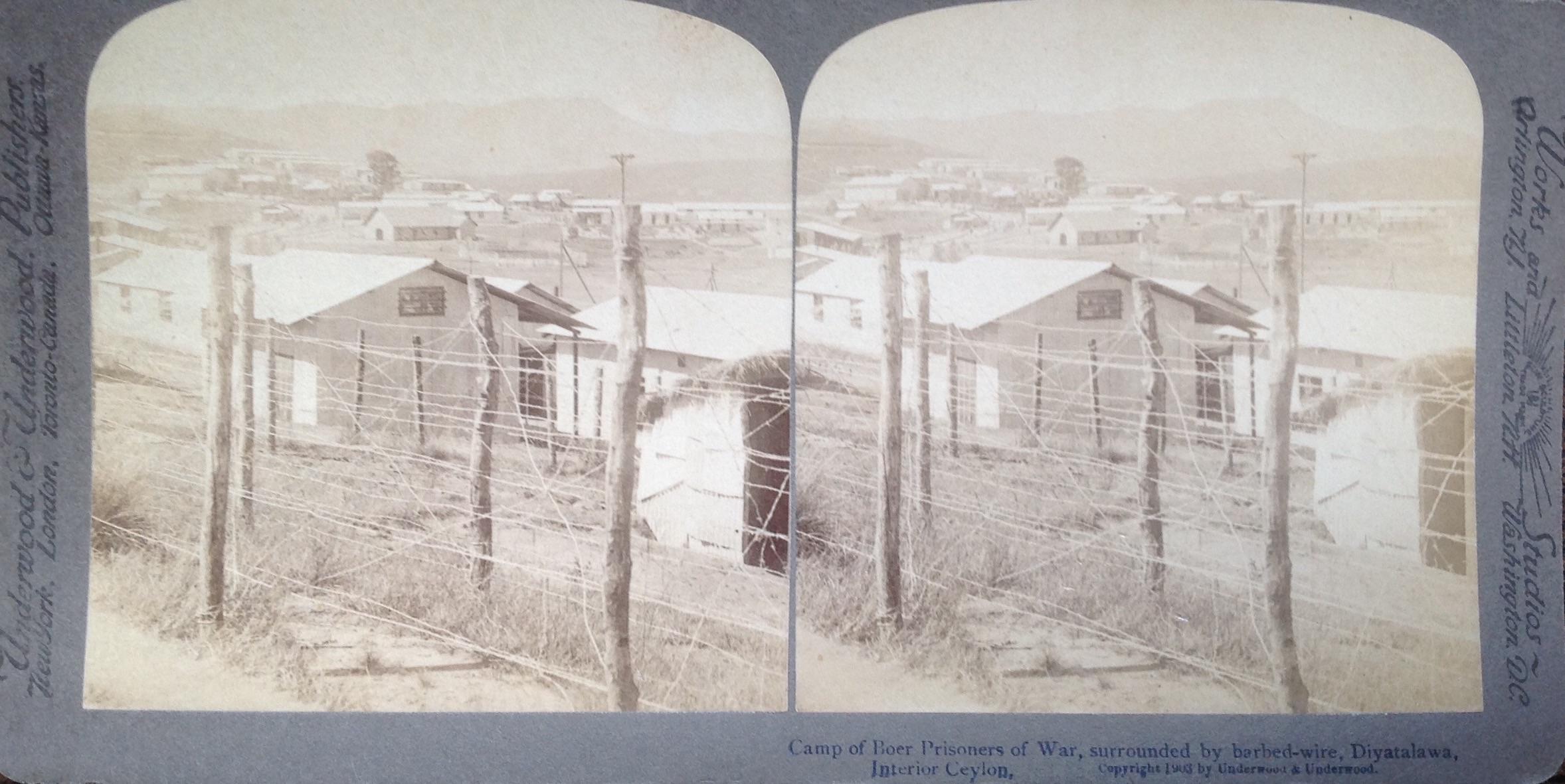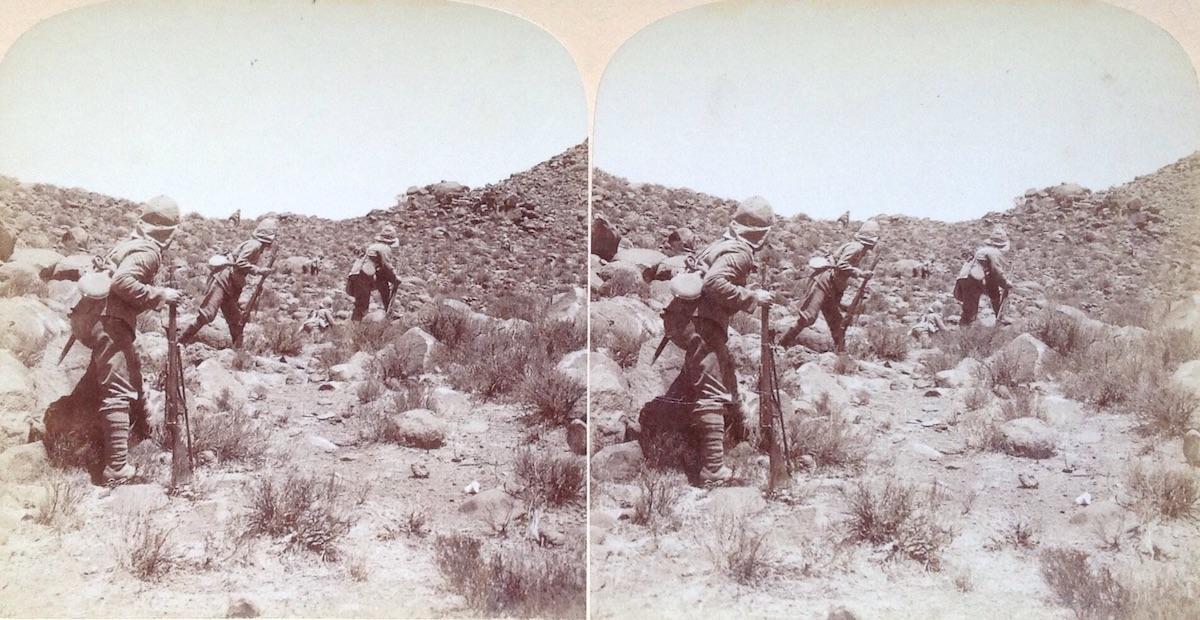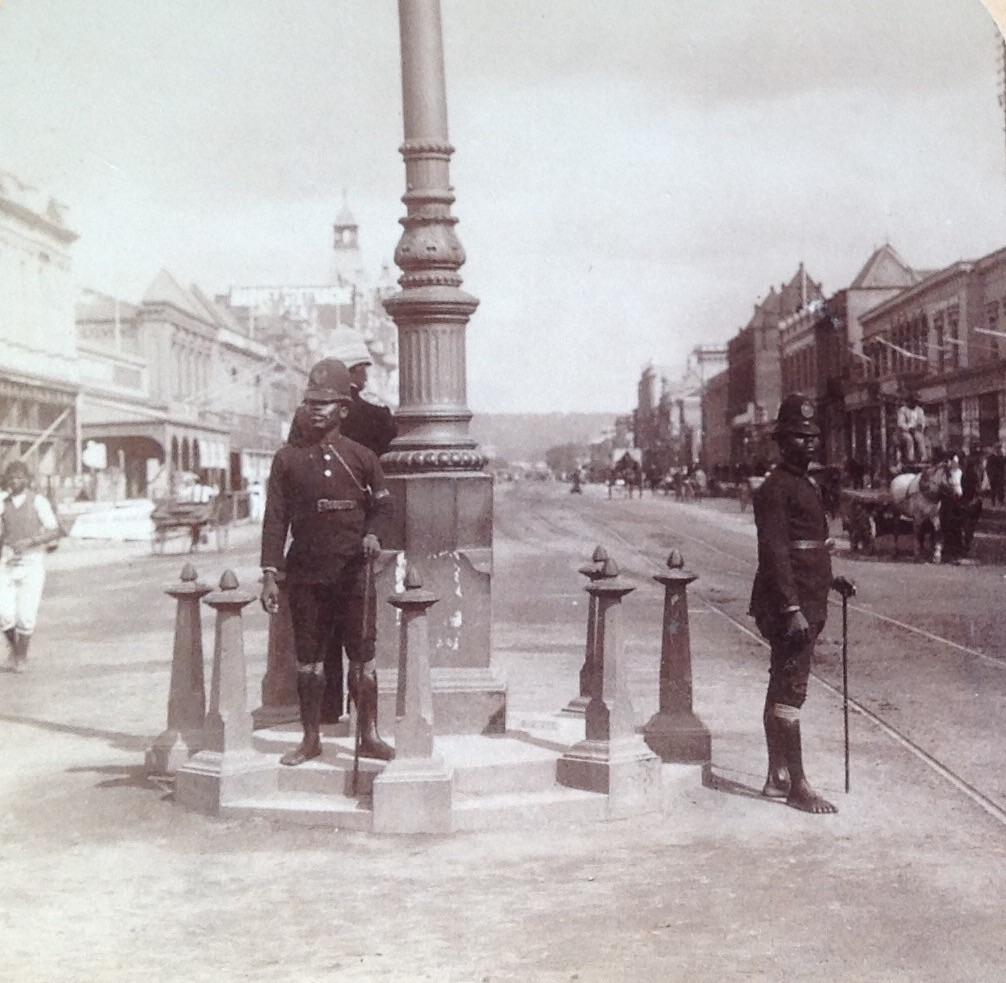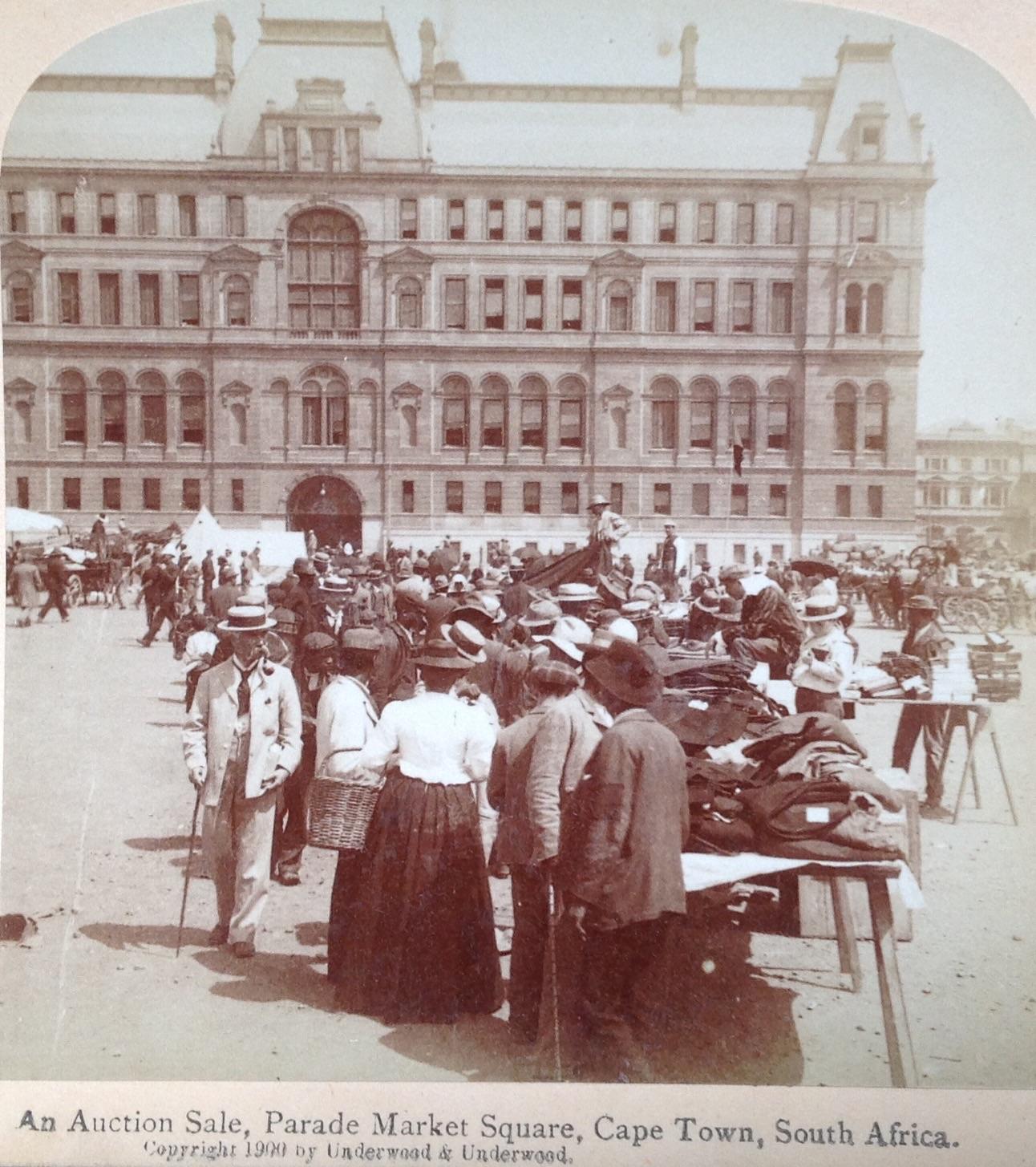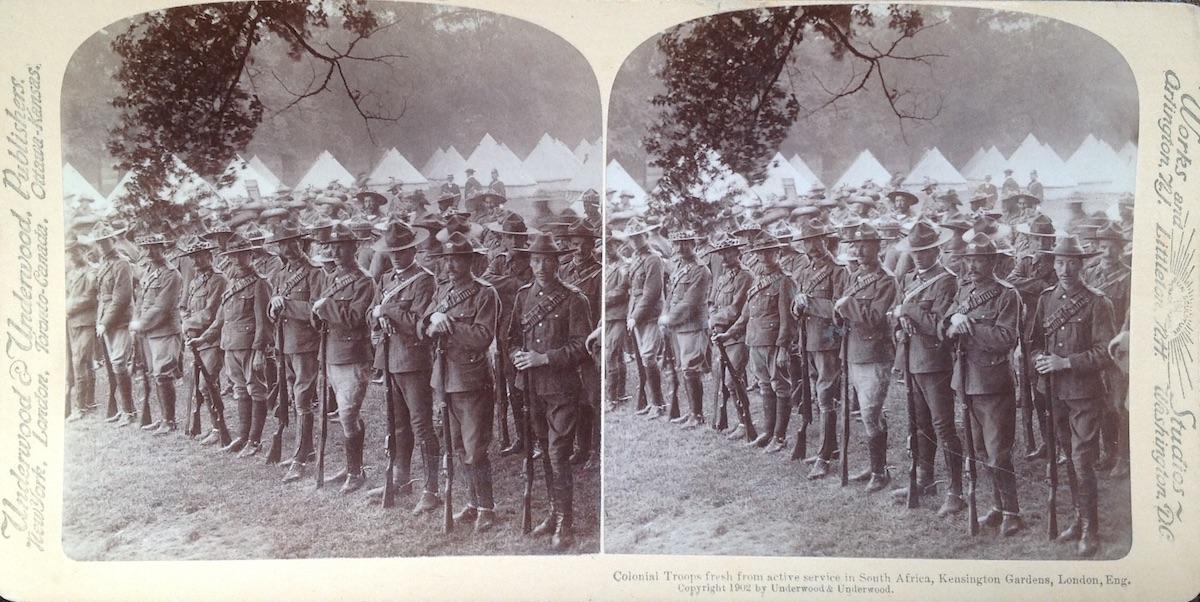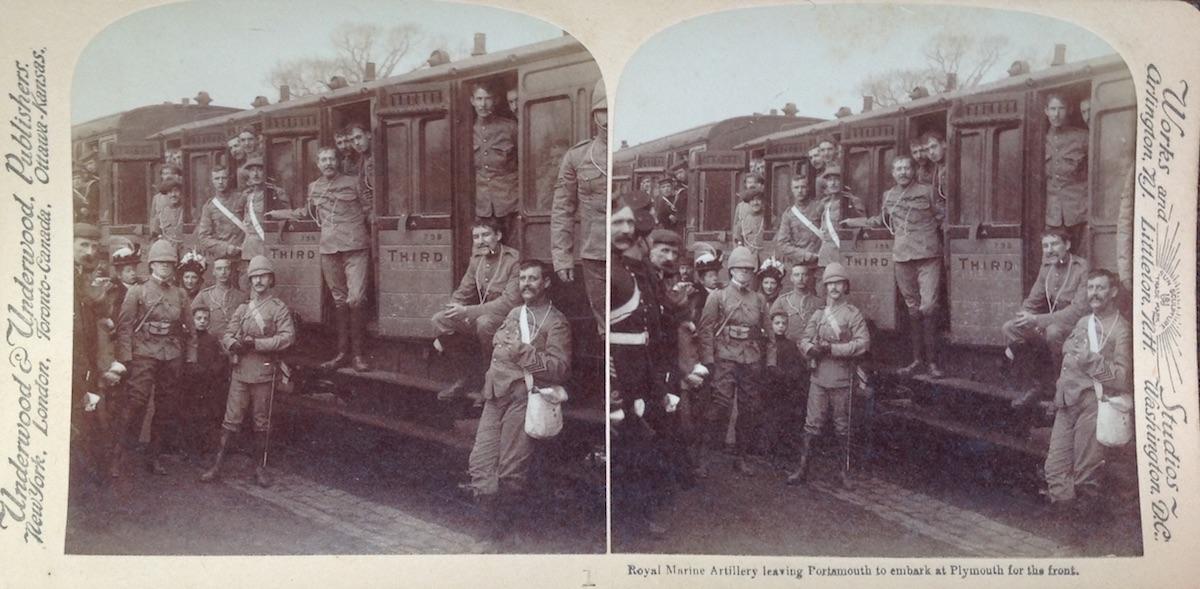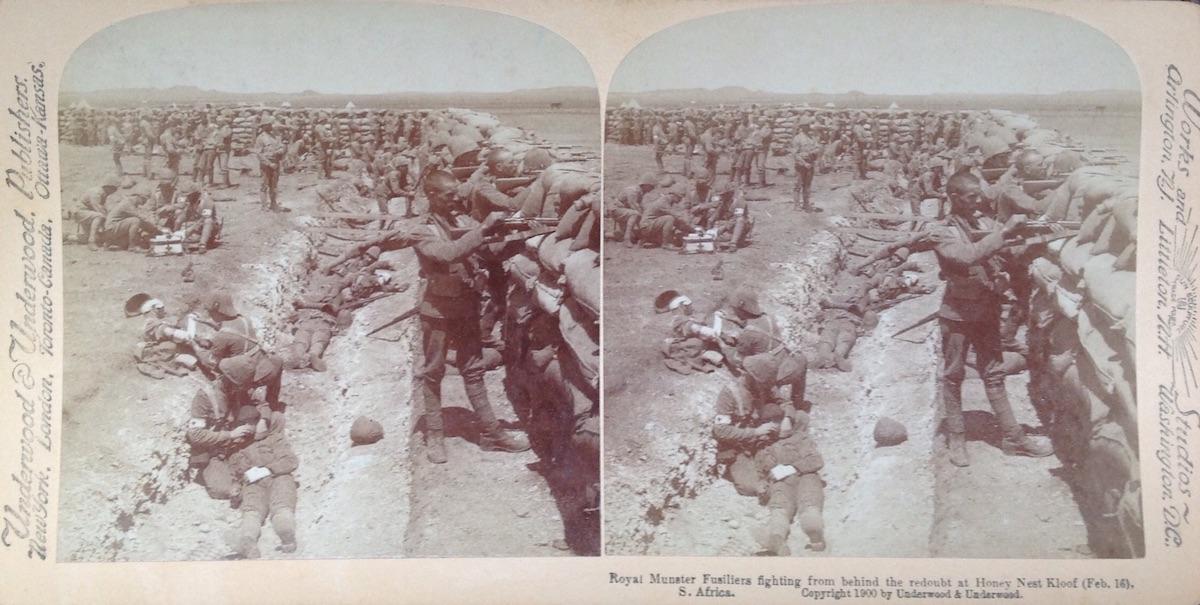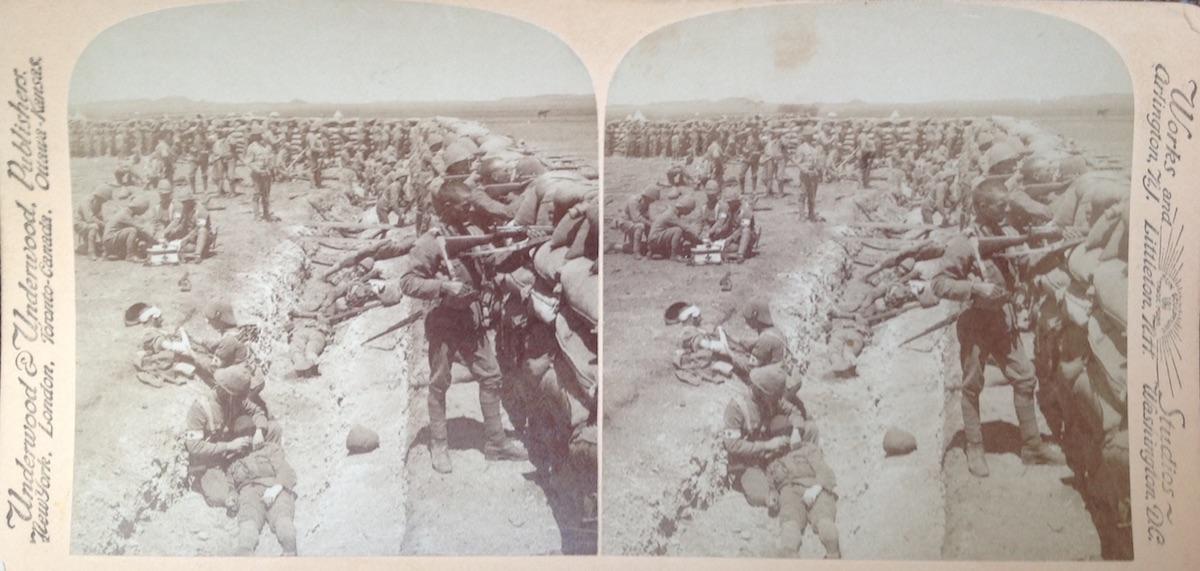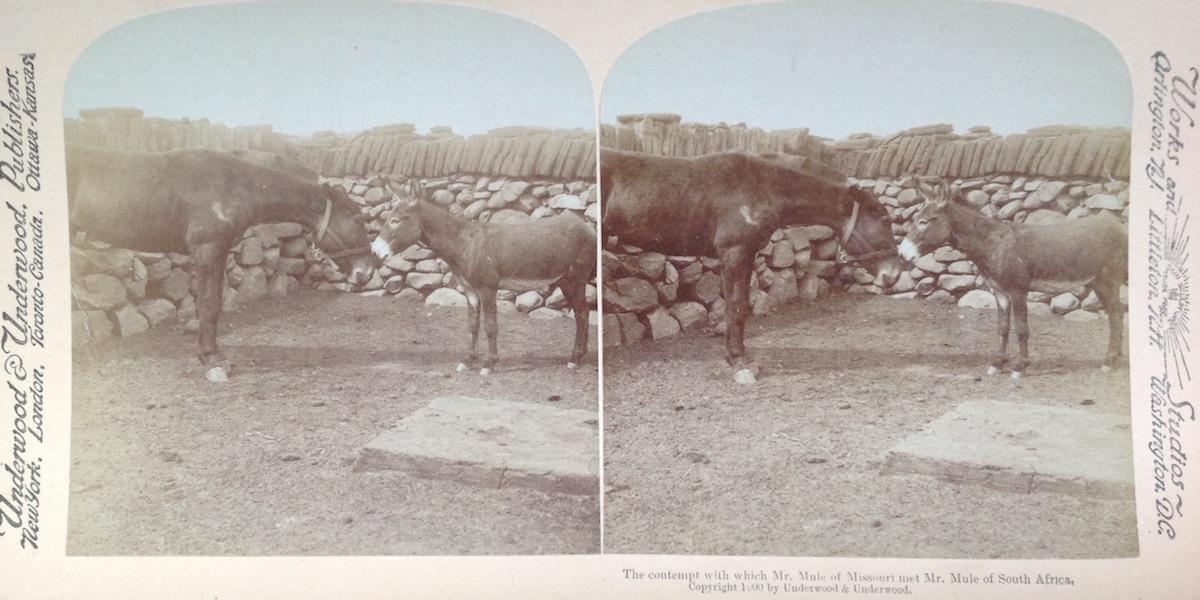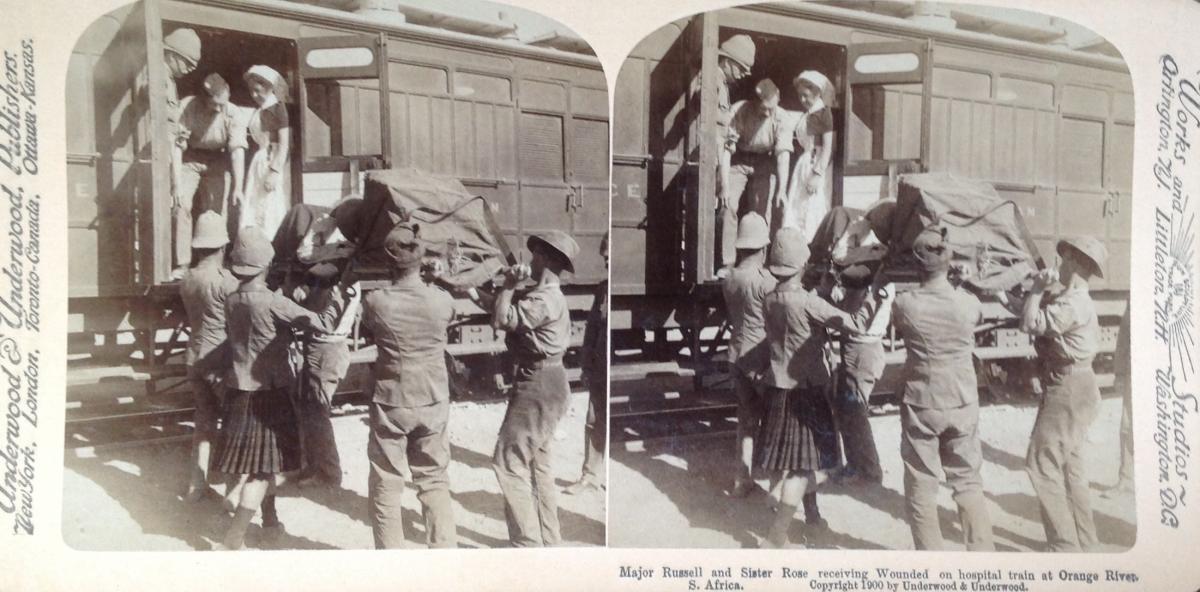
Disclaimer: Any views expressed by individuals and organisations are their own and do not in any way represent the views of The Heritage Portal. If you find any mistakes or historical inaccuracies, please contact the editor.
The primary purpose of this article is to introduce the first known catalogue (Version 1 – as at November 2018 - click here to download) of Anglo-Boer war stereographic images produced by the American based Underwood and Underwood Publishing Group.
War correspondents and news photographers descended upon South Africa at the start of the Anglo-Boer war, among them the photographers of Underwood & Underwood. These photographers were not news photographers after sensational, gory war images, nor were they part of any pro-British or anti-Boer propaganda campaign. They stayed away from conflict zones but still captured other military related activity with their primary market, namely the American middle class in mind.
Underwood and Underwood produced sets of images in boxes made to look like a single, or a pair of books entitled: “The South African War through the Stereoscope”. These boxes were then filled with Anglo-Boer war stereo photographs pasted onto curved cardboard. More titles were added as the war progressed.
Wooden stereo camera similar to that used by Underwood and Underwood photographers during the Anglo-Boer war
What is a stereoview?
The stereoscope was invented as early as 1838 by Sir Charles Wheatstone and improved through the years.
Stereoviews became a popular photographic medium worldwide. Since 1851, stereo photographs were produced on a large-scale in the UK and Europe before they became widely distributed in the United States by the 1880s.
The London Stereoscopic Company alone was selling some half-a-million stereo photographs between 1854 & 1856. The craze was so big that they coined a slogan as early as 1854 stating: “No home without a stereoscope”.
Preceding cinema and television, stereo photography became the first universal system of communication in that between 1850 and 1930s stereo photography was a popular form of home entertainment and home tourism. It became a natural educational tool.
The reason for the growth in popularity of “stereo viewing”, from the mid 1800s onwards, lies in the increase in literacy levels, improved social conditions as well as an uptake in world-wide travels.
Ultimately, commercial success became the key driver in the publication of stereo images.
The stereograph, or stereoview, consisted of a double set of paper print photographs mounted on cardboard stock to be placed in a stereoscope or viewer. When viewing these two almost identical images through the stereoscope, or stereo viewer, a three-dimensional image revealing an integrated stereoscopic image was produced. The visual cortex of the brain fuses these two images into a perceived three-dimensional scene or composition.
Stereoviews were initially produced on glass but later the paper version was pasted on a flat piece of carton. These cartons, or cards, only became curved from 1880s onwards to produce an even better three-dimensional effect when viewed through a viewer.
Through the business efforts of companies such as Underwood & Underwood, Keystone View and Kilburn, stereo photography reached their peak in the years 1902-1935.
Balloons were used for observation purposes by the British. It has been suggested that the British Engineers brought three hydrogen-balloon detachments to South Africa during 1899. The balloons never “flew”, but were anchored with ropes. The images above are some of the few stereo images that actually show the British forces on the move.
The Underwood Brothers
Later described as the leaders in armchair travel photography, Underwood & Underwood was founded by two brothers in 1881 in Ottawa, Kansas. The brothers were Elmer Underwood (born Fulton County, Illinois 1859 - died St. Petersburg, Florida during 1947) and Bert Elias Underwood (born in Oxford, Illinois 1862 - died Tucson, Arizona during 1943). The company moved its main office from Ottawa, Kansas to New York City 10 years later.
During the late 19th and early 20th century, Underwood and Underwood (To be referred to as U & U from this point onwards) responded to the increasing demand of their primary market, namely the middle-class American’s visual curiosity on the expanding world.
Images of the new frontiers were popular, so were images of conflict involving Americans such as the Spanish American war and the Boxer rebellion or the Anglo-Boer as well as the Russian-Japanese wars.
Images of heavy artillery remain popular amongst collectors (The titles of the two images above appear on line 344 and 430 respectively in the attached catalogue).
U & U were the inventors of the “canvassing” sales approach, namely house-to-house selling, which mostly employed college students. It has been suggested that in one American summer alone that some 3000 of these college students were at work, successfully selling stereoview sets.
From 1897 onwards, U & U employed full-time as well as freelance photographers. By 1901 the Underwoods were publishing 25 000 stereographs per day (total number of cards – not different images).
The company also established branches in Baltimore, London, and Canada. During 1920 their stereographic production was discontinued and U & U sold their stereographic stock and rights to the Keystone View Company. The Keystone company continued to republish some of the U & U images under their own name.
Feeding the soldiers was a full time task for some. Above British soldiers, as well as local Indian men, recruited by the British, can be seen baking bread in field-ovens.
Underwood & Underwood in South Africa
The Anglo-Boer war was not the first war to be captured stereographically. The American Civil war (1861 – 1865) carries this honour.
The Underwoods hired their own photographers, some of whom were Americans. Unfortunately, none of their names have been recorded on the Anglo-Boer war stereo cards or on the photographs themselves.
It is thought that some photographs may also have been bought from South African based photographers by U & U. This would however have been an absolute exception and not the rule.
The Anglo-Boer war images sold door to door in America would have formed but a small fraction of the wide variety of images and themes on offer by U & U.
It is known that the Reid Brothers, based at 19 Roeland street in Cape Town, were the main distributors of the images in South Africa in that many cards found in South Africa today have the rubber stamp of this firm applied on the back of the cards. The Reid Brothers also published their own range of stereoviews around 1915/16. One of the known themes published by them is the “Army Series”.
It has been recorded that Tielman Johannes Roos bought a set of these photographs from a local U & U sales representative (may have been the Reid Brothers) for around £10 during 1915. This confirms that the images were still being produced, boxed and sold in South Africa some 15 years after the war.
Although it has been suggested that some 3000 photographic titles of the war have been produced by the Underwoods, the author is of the view that this figure more than likely represents the combined number of images produced by the various publishers of Anglo-Boer war stereo images.
Erasmus (2012) suggested that between 280 and 300 Anglo-Boer war stereoviews were published by U & U. Following the research by the author of this article, some 525 titles by U & U have been identified to date (excluding any duplicated titles).
The author is of the view that between 50 and 120 more titles, or variations thereof, await to be identified and recorded.
Same title – two different images. The photographer clearly stood at the same spot as the soldiers walked past taking a number of pictures. Card titled: “British prisoners released by the Boers, marching into Pretoria after its capture, to be rearmed” (Line 79 of attached catalogue). This image would therefore have been taken shortly after 5 June 1900.
Anglo-Boer war and the Underwood & Underwood images
A diverse set of opinions existed amongst the Americans about the war in South Africa. It was observed that the American press and white public sympathised with the Boers whilst the political elite and African Americans were inclined to side with the British.
Whilst scenes of both the British and the Boer troops were photographically captured by U & U photographers, the larger portion of the photographs were of the British.
U & U photographers used bulky stereo cameras which had two lenses by which the stereoscopic effect was achieved. The cameras, mounted on tripods, did not use dry films but glass plates. These cameras were not suitable for action photography in that they were heavy and difficult to move around or set up in the rough terrain. Lengthy exposure times also made action photography impossible.
Reflecting on the grim realities of the war was not part of the U & U programme. The dead were never photographed and battle scenes showing the dying or dead bodies were staged – embalmed in the nineteenth century heroic rhetoric. Photographers typically visited and photographed scenes where conflict occurred after the event. Many of these photographs turned out to be dull and uninteresting in that they were images without any detail or sufficient depth of field – just a landscape.
Both the above images were clearly posed for. No Underwood & Underwood stereo images exist of actual war casualties
After June 1900, the Anglo-Boer war was no longer newsworthy, resulting in many photographers leaving the country, thinking that the war was over. During June 1900, the Boxer uprising in China shifted the public’s interest. The largest portion of the Anglo-Boer war stereo images were therefore taken between the start of the war (October 1899) and the arrival of the Lord Roberts in Pretoria (5 June 1900), a relatively short period of 9 months.
Due to the photographers leaving the country, no images exist of the guerilla phase of the war or the scorched earth policy. Studio images, in stereo format, do however exist of leaders taken post June 1900. Some images taken post the war also have a descriptor starting with “Ex…”, confirming that they were taken post the war. It may also be that most of these images were sold to Underwood & Underwood by local photographers’ post June 1900.
No stereo images relating to concentration camps have been identified to date.
It has also been suggested that no prisoner of war images were produced by U & U. To date evidence of one such image has been found (See line 89 in attached catalogue – taken at the Diyatalawa camp in Ceylon).
It is thought that the photographs of General de Wet (with his personal secretary) and General de la Rey may have been captured post the war. The de la Rey image was taken in a studio. It is assumed that this image was bought by Underwood & Underwood from a South African based studio photographer
Although suggested before that Underwood & Underwood did not take photographs of Boer Prisoner of war camps, this photograph taken at Diyatalawa (Ceylon), suggests otherwise (Line 90 of attached catalogue)
Stereoviews of most interest remain the portraits of key military figures, followed by scenes of damaged bridges, medical personnel & hospitals, heavy artillery or balloons used for reconnaissance purposes.
Each stereographic card has a title or descriptive caption at the bottom of each image. It is these titles that have been used to put together the attached catalogue. Some of the cards also have the descriptor applied on the back of the card in six different languages.
Most of the images deal with the action on the north-eastern frontier of the Cape between November 1899 and February 1900 including scenes from Hanover, Naauwpoort, Dordrecht or Arundel and Rensburg (South of Colesburg).
U & U photographers were also present on the march to Kimberley, at the surrender of General Cronje at Paardeberg, at the occupation of Bloemfontein, on the march through the Free State towards Johannesburg and the triumphant entry into Pretoria. Images of the Natal campaign (siege of Ladysmith), battlegrounds of Colenso and Spioenkop are also included.
Occasionally the same image was used to describe different events. The posed image above was issued with the following two very different descriptions and vastly different dates: “British mounted Infantry feeling for the enemy, morning of June 4th, nine miles south of Pretoria” (Line 78 of attached catalogue) and “Montmorency's scouts finding Boer position near Dordrecht, Dec 29th - South Africa” (Line 312 of attached catalogue) – This begs the questions - where was this image actually taken?
As mentioned above, no images of actual engagement on the battlefield exist. The images captured mostly present static scenes. The stereoviews presented a “sanitised” picture of military life in tented camps, parades, blown-up bridges, cavalry fording rivers, soldiers lined up in trenches or provision of food for both soldier and horses.
There are several stereoviews amongst the war images which depict images and scenes which are not directly related to the military aspects of the war. These images were produced by U & U to fit in with the general aim of education. Several images of peaceful South African town or village street scenes, or the South African population (especially of the Zulu nation) were also captured by the U & U photographers whilst residing in certain cities or traveling between the various locations capturing images of soldiers on the move.
U & U also produced stereo images of South African scenery post 1910 – These images were not the focus of this article.
Underwood & Underwood photographers assigned to photographing the Anglo-Boer war did not restrict themselves in capturing images of the war only. Whilst they were passing through towns, they also captured images of day-to-day activity of the local population. The two images above show Zulu police men in West street in Durban and civilians attending a market in Cape Town (men in uniform can be spotted in the latter image)
About the catalogue (click here to download):
- Some identical images have different titles (These variants have been recorded accordingly in the attached catalogue);
- The photographers had the posing soldiers at their command. Photographers often took more than one image per scene, resulting in the same stereoview title appearing up to three times, all three with a slightly different composition (mainly due to the soldiers having moved slightly between the photographic exposures) - These variants are indicated by either (x2) or (x3) at the end of the relevant tiles in the attached catalogue;
- Some cards have clearly been produced in higher numbers compared to others;
- Spelling mistakes in the titles were common (and remain largely unchanged in the attached catalogue);
- There was no logical sequence or numbering applied to the cards included in the boxes. Numbering was purely applied per set, creating the impression that there was a logical numbering system applied. It may therefore be found that one image alone may have vastly different numbers applied. Boxed sets of these photographs did therefore not have the same content and where they did, they were not necessarily numbered in the same sequence;
- The initial card stock was yellow/beige in color whilst later issues were mounted on grey cards (The attached catalogue does not record these color differences in the cards);
- Not all images were taken on South African soil – Some images were taken of the British soldiers whilst on British soil.
Not all the Anglo-Boer war stereo photographs were captured in South Africa. A few were also taken of soldiers on British soil. The two cards above are titled: “Colonial troops fresh from active service in South Africa, Kensington Gardens, London” (Line 114 of attached catalogue) and “Royal marine artillery leaving Portsmouth to embark at Plymouth for the front” (Line 378 of attached catalogue)
The attached catalogue was put together by recording images from several private South African based collections. The research needs to be expanded by studying and recording images in the collections of various museums and Universities, local and abroad. Variants can only be identified by visually comparing cards with each other – the most optimal way of doing so for any researcher would be by inspecting cards in person.
The attached catalogue does not include any cards produced by U & U during the St Louis World fair held during 1904. The Anglo-Boer war was re-enacted at this event. More research is required to determine the number of cards published at this event.
The above two images are almost identical. The soldier standing in front can be seen with his right hand on the rifle in one image and with his right hand on his side in the second image. A third variation also exists. Card is titled “Royal Munster Fusiliers from behind the redoubt at Honey Nest Kloof (Feb 16)” (Line 381 of the attached catalogue)
Acknowledgment
- The catalogue was combined with input from the following collectors/ex-collections over a 12-year period: Ron Cowan, Mervyn Emms (†), Hardijzer Photographic Research collection, Judd Kirkel, Kerneels Laubscher, Ray Lepan, Nigel Mason, Chris Smit and Boet van der Walt (†). (The Kirkel and Hardijzer photographic research collection are the two most extensive private South Africa based collections known of).
- Professor Anton van Vollenhoven and Estelle Pretorius for their assistance in sourcing the Erasmus (2012) article.
Humor was not excluded. This card reads: The contempt with which Mr. Mule of Missouri met Mr. Mule South Africa (Line 455 of attached catalogue)
Fellow collectors, researchers and readers worldwide are invited to inform the author of any new titles not recorded in the attached catalogue (carol.hardijzer@webmail.co.za).
Main image: Card is titled “Major Russel and Sister Rose receiving wounded on hospital train at Orange River” (Line 306 of attached catalogue). The hospital train transported wounded soldiers to Pretoria.
About the author: Carol is passionate about South African Photographica – anything and everything to do with the history of photography. He not only collects anything relating to photography, but also conducts extensive research in this field. He has published a variety of articles on this topic and assisted a publisher and fellow researchers in the field. Of particular interest to Carol are historical South African photographs. Carol has one of the largest private photographic collections in South Africa.
Sources
- Erasmus, H.J. (2012). The Underwood & Underwood stereographs of the Anglo-Boer war 1899-1902. South African Journal of Cultural History, Volume 26, Issue 2, P61-82
- Hardijzer, C.H. (2017). Unique photographs from the Boer War. (theheritageportal.co.za)
- Hardijzer, C.H. (2017). Stereo Photography – Mesmerising viewers since 1851. (theheritageportal.co.za)
- Lee, E. (1986). To the bitter end – a Photographic history of the Boer war 1899-1902. Penguin Books. Middlesex.
- Stereoheaven. Meet the famous stereo photographers (www.stereoheavan.com)
- The Yellowstone Stereoview page – Underwood & Underwood. (www.yellowstonestereoviews.com)
- Smithsonian Institution. Guide to Underwood & Underwood glass stereograph collection.
- University of Chicago Library. Underwood & Underwood Collection 1899 – 1908 (www.lib.uchicago.edu)
- University of Washington Library Digital Collection (http://content.lib.washington.edu)
- Wikipedia.org – Underwood & Underwood
Comments will load below. If for any reason none appear click here for some troubleshooting tips. If you would like to post a comment and need instructions click here.

